Con Son - Kiep Bac Complex Con Son - Kiep Bac complex, a sacred place to visit is one of the most legendary places which associates to the long history of thousands year of Vietnam. Every year, countless pilgrims and tourists around the country have made the journey to the sacred region of Con Son-Kiep Bac, especially on the spring and autumn festivals.
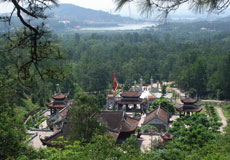 Con Son consists of Ky Lan Mountain, Ngu Nhac Mountain and Con Son Lake. It is a gravel mountain of about 200 meters high, bearing a resemblance to a resting lion with a shrine on the top. Its 238-meter northern ridge adjoins Ngu Nhac Mountain and the three mountain peaks rising look like a unicorn kneeling, hence it named Ky Lan (kylin).
Con Son consists of Ky Lan Mountain, Ngu Nhac Mountain and Con Son Lake. It is a gravel mountain of about 200 meters high, bearing a resemblance to a resting lion with a shrine on the top. Its 238-meter northern ridge adjoins Ngu Nhac Mountain and the three mountain peaks rising look like a unicorn kneeling, hence it named Ky Lan (kylin).
Con Son Pagoda, also known as Hun Pagoda or Thien Tu Phuc Monastery, is located in Cong Hoa Commune, Chi Linh District, Hai Duong Province. It was built in the 13th century and repaired and expanded with more complicated features in the 17th and 18th centuries. The pagoda, which has undergone several restorations during recent years, has 83 rooms with 385 statues; some of which are two to three meters in height. The first statue to come into sight is the 3-meter high Amida statue, on a large pedestal in the pagoda. Behind the pagoda and separated by a small yard in an ancestor house are statues of three founders of Truc Lam Buddhist Zen (Tran Nhan Tong - Phap Loa - Huyen Quang) and Tran Nguyen Dan and his wife. In addition, other two statues have just been identified as the statues of the great national hero Nguyen Trai, the World Cultural Celebrity, a talented military and political activist, and a great writer in the 15th century, and his concubine Nguyen Thi Lo.
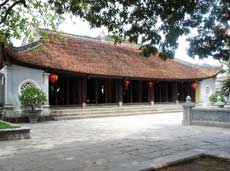 The pagoda was ranked as a national relic for the first time in 1962 and then recorded as a very important relic to be preserved 32 years later, in 1994.
The pagoda was ranked as a national relic for the first time in 1962 and then recorded as a very important relic to be preserved 32 years later, in 1994.
One tower-grave named Dang Minh Bao Thap is located behind the pagoda, by the path leading to the mountain and under the green canopy of large trees. The five meter high tower was built from blue stones at the site of the grave Huyen Quang scholar. A statue of the scholar is inside the tower.
Behind the tower-grave is a wide path with ancient pine trees growing on both sides and footsteps leading to the peak of the mountain. Censers spread their sweet fragrance and the clumps of peonies with dark blue leaves blossom into blazing red flowers at the formerly Buddhist hermitage.
On the way up Ky Lan Mountain visitors can call at Gieng Ngoc (Pearl Well), known as the eye of the kylin, at the foot of Dang Minh Bao Thap. Legend has it that in the full moon night of the seventh lunar month, Bonze Huyen Quang was sleeping in his room at Con Son Pagoda dreamt of seeing a shiny pearl on the side of the mountain. He wanted to get closer to scrutinize the pearl, but the sound of the pagoda’s bell woke him up. However, he could not stop thinking about his dream. So together with his assistants, Huyen Quang went to the mountain. There he found a well containing fresh and cool water. When the monk returned to the pagoda, he held a ceremony to thank the deities for the precious source of water. He also made the well deeper. Since then, the Pearl Well’s water has been offered in rituals at the pagoda.
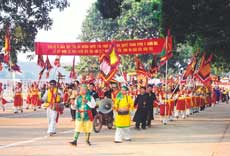 Six hundred rocky steps lead up to the peak. At the peak is Am Bach Van (White Cloud Temple) where the hero Nguyen Trai lived at the end of his life. Next to it is Ban Co Tien (fairy chessboard) and several other large flagstones called “immortal chessboards†by local residents. According to legend, heavenly deities had ridden clouds to Con Son Mountain to play chess there.
Six hundred rocky steps lead up to the peak. At the peak is Am Bach Van (White Cloud Temple) where the hero Nguyen Trai lived at the end of his life. Next to it is Ban Co Tien (fairy chessboard) and several other large flagstones called “immortal chessboards†by local residents. According to legend, heavenly deities had ridden clouds to Con Son Mountain to play chess there.
The stone path down to the base of the mountain leads to two huge, smooth and flat rocks beside the Con Son Spring called Thach Ban (stone table). It is said that Nguyen Trai used to sit on these rocks to compose poems and ponder national issues.
Next to Con Son Spring, a temple is dedicated to Nguyen Trai was built in December 2000 and inaugurated in 2002 in celebration of the 600th birthday anniversary of Nguyen Trai.
There are two festivals to be organized at Con Son Pagoda annually. The Spring Festival is from the 18th to the 22nd day of the first lunar month, worshipping to Bonze Huyen Quang. The Autumn Festival is from the 16th to the 20th day of the eighth lunar month, worshipping to Nguyen Trai.
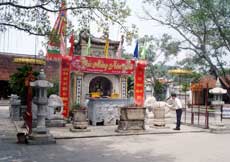 Some kilometers to the west is Kiep Bac Temple which was built in the beginning of the 14th century in the centre of Kiep Bac valley. It used to be place where the national hero Tran Hung Dao, the commander of the Resistance troops, garrison camp after the first victory over the Yuan invaders in 1258.
Some kilometers to the west is Kiep Bac Temple which was built in the beginning of the 14th century in the centre of Kiep Bac valley. It used to be place where the national hero Tran Hung Dao, the commander of the Resistance troops, garrison camp after the first victory over the Yuan invaders in 1258.
Kiep Bac is located in a rich valley surrounded by the Rong (Dragon) Mountain in Hung Dao Commune, Chi Linh District, Hai Duong Province. The surroundings give Kiep Bac a secretive, poetic, and dreamy feature.
Every year from the 15th to 20th days of the eighth lunar month, tens of thousands of people throughout the country come here to attend the Kiep Bac Temple Festival. It is considered as one of the largest festivals in the Red River Delta region. It is the father’s death anniversary of the nation.
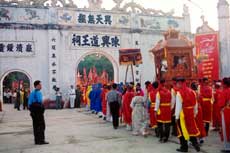 Since these two famous vestiges close together and being aware of the importance of them, a big money will be spent from now to 2025 to restore and expand to be a complex and make it become an attractive tourism and historic center not only in the region but also in the country. And the same, two festivals of two vestiges are organized at the same time together twice a year for spring and autumn festivals. They are the notable events in the region and known as Con Son - Kiep Bac Festival.
Since these two famous vestiges close together and being aware of the importance of them, a big money will be spent from now to 2025 to restore and expand to be a complex and make it become an attractive tourism and historic center not only in the region but also in the country. And the same, two festivals of two vestiges are organized at the same time together twice a year for spring and autumn festivals. They are the notable events in the region and known as Con Son - Kiep Bac Festival.
The Con Son Festival and Kiep Bac Temple Festival is going to be restored with all its traditional rituals during 2008-2009 to be ready for a national festival in 2010.
More information:
Program of Con Son - Kiep Bac Autumn Festival 2009
+ Kiep Bac Festival:
- On September 28, 2009 (the 10th day of the eighth lunar month): Cao yet ceremony (ceremony for opening temple);
Dien xuong hau Thanh Ceremony (a typical ritual that is the combination of music, singing, dancing and worshipping).
- At 19h00 every day from September 29 to October 3, 2009 (from the 10th to 15th days of the eighth lunar month): Dien xuong hau Thanh Ceremony.
- From 6h30 to 12h00 on October 4, 2009 (the 16th day of the eighth lunar month): Walking procession and memorial ceremonies; Troop Festival on the Luc Dau River.
- At 21h00 on October 4, 2009 (the 16th day of the eighth lunar month): Ceremony of confer seal of the Holy Tran.
- At 19h00 on October 5, 2009 (the 17th day of the eighth lunar month): Ceremony of long for peace and night festival complete with flower garlands and coloured lanterns on Luc River.
- At 8:00 on October 6, 2009 (the 18th day of the eighth lunar month): boat racing, paddling;
and the same day at 19h00: Dien xuong hau Thanh Ceremony.
- At 19h00 on October 7 and 8, 2009 (the 19th and 20th days of the eighth lunar month): Dien xuong hau Thanh Ceremony.
+ Con Son Festival:
On October 4, 2009 (the 16th day of the eighth lunar month): Incense-offering Ceremony in Nguyen Trai Temple and Con Son Pagoda.
In addition, there are also many folk games, sports competitions and excellent arts performances such as wrestling, cheo (traditional operetta), quan ho (love duets)... during the festival.
Phuong Anh (Edited)